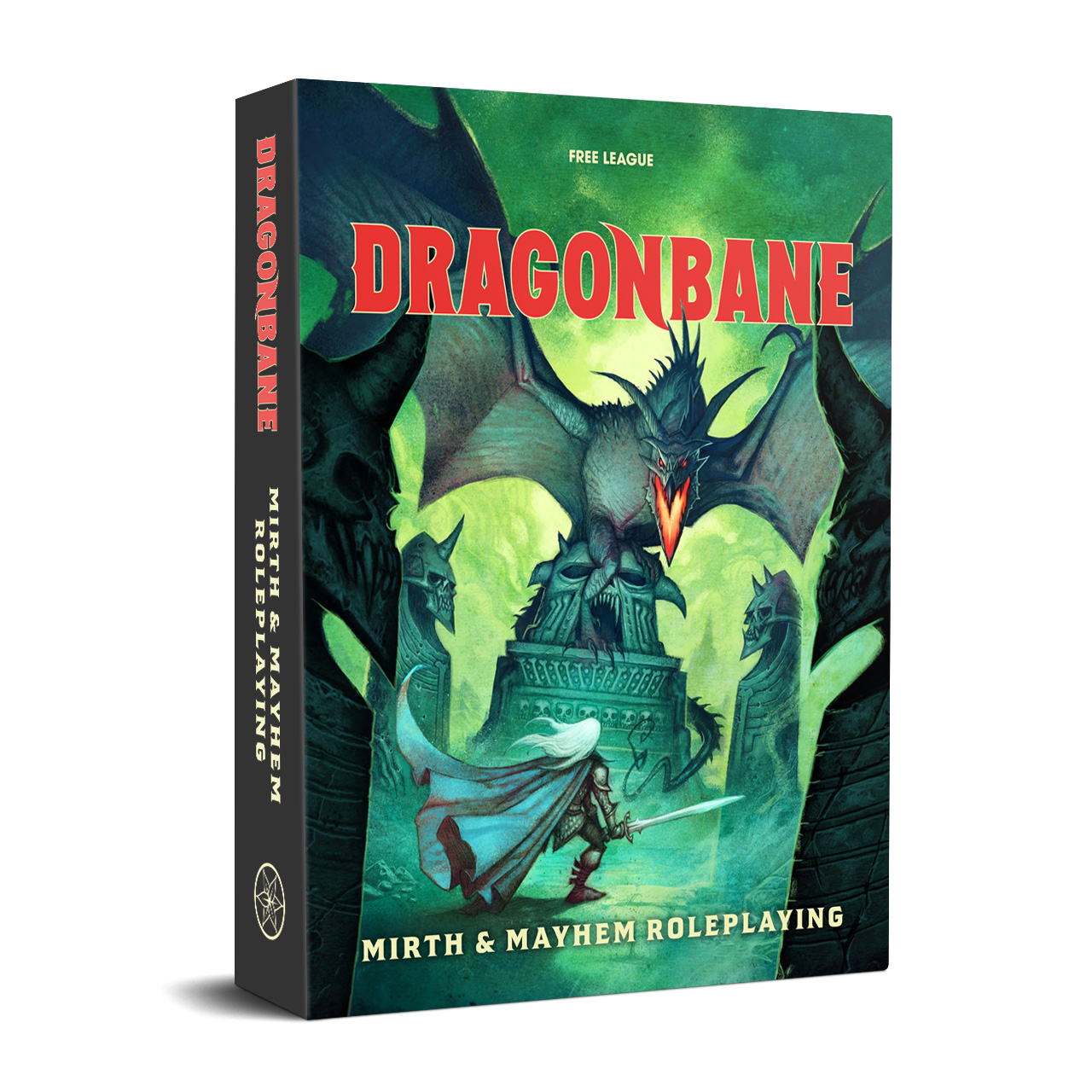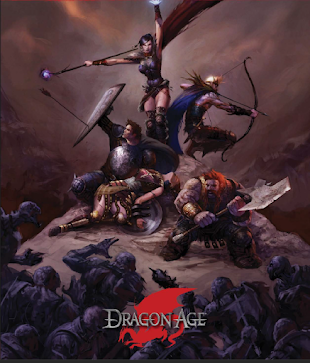Dragonbane BETA
A lot of skill(s)
Reading through the rules document we got the impression
that Dragonbane presents a swingy, but fast resolution mechanic. Nearly every
situation encountered in the game is resolved through the skill system. Want to
make an attack with your sword? Want to look for traps? That's a skill. Want to
see if you remember an interesting bit of lore? That's a skill.
What makes the game quick is this resolution mechanic.
Dragonbane flips the traditional convention of rolling a D20 on its head, at
least compared to a system like 5E. In Dragonbane, 20’s are no longer the
number you want to roll. Instead, lower
is better with 1’s being the best result. This is because you want to roll
below the target number which is your skill value. Therefore, the higher your
skill value is, the more likely you are to succeed.
From a resolution standpoint, this is very quick to
adjudicate. Now there are no modifiers that need to be added to the die. You
immediately look at what’s been rolled on the die and compare it to your
relevant skill. In this way, too, combat has been simplified. It's no longer a
test of whether you as the combatant are skilled enough to inflict lasting
damage on your opponent by exceeding their armor class. But rather it's
a question of are you as a combatant skilled enough with the weapon that you
are using. It’s a subtle difference but an extremely interesting one. If you
are skilled with swords and you roll under your sword skill, you have hit your
target and are able to deal your damage. This makes combat quick.
Combat is similar to many other RPG’s where once it is clear
a confrontation is beginning, initiative is determined and turns are played out
in order. Dragonbane uses a deck of cards number 1-10, drawn randomly, to determine
initiative order. There are of course specific cases where the cards and draws
can be manipulated to gain more advantageous turn orders. Like d20 rolls, lower
on the card order is better. Lastly, initiative is determined each round with
the cards being collected, shuffled, and redrawn so turn order varies round-to-round.
The action economy and the round-to-round initiative
reshuffling provides a dynamic feel to combat. It also makes combat feel very
tactical. Combat itself is also quite a bit different from what you may be used
to, if you cut your teeth on 3rd, 4th, or 5th edition D&D,
though 1st edition players might have a little bit more of a leg up
here. Earlier editions of Dungeons and Dragons often used a round-to-round
initiative order system.
The varying initiative order is important to mention, because
in Dragonbane, monsters always hit. Since your character has no armor class, an
enemy NPC who's a humanoid will have to roll their weapon skill to see if they
succeed, like a PC would. But the entire class of enemies known as Monsters
always hit. Monsters don't always deal damage, but when they do deal damage,
oftentimes it is an extreme amount of damage. The game does provide ways to
soak this damage using armor. Oftentimes it won't be enough to soak all the
damage dealt to your character since hit point maximums are set at character
creation and very rarely change this level of lethal damage will be a concern
throughout the entirety of a Dragonbane campaign.
There is a way to mitigate this lethal damage, though. If
you haven't acted yet in combat, you still possess your action for the round.
You can spend that action outside of your turn, to attempt to either parry an
incoming attack or evade it all together. Some monster attacks may be parried,
but not all, but most of them can be evaded, thus negating the monsters attack
and damage completely.
There is a chance of failure for this though, and on a
failure, your character will still receive the full effect of the monster’s
attack. One of the consequences of this mechanic is that the Evade skill is
very important, and if you're not going to play a character with a high Evade
skill you need to have lots of armor or be good at parrying.
So again, this limited action economy, but changing
initiative order, provides a very strategic feel and allows for dynamic combat.
Decisions must be made situationally, am I going to act after the monster? If
so, I'll wait to see if I need to Evade. Maybe the effect of the monster this
round is that I must resist being frightened, or I must roll to resist poison.
If that's the case, then I still have my action and can use it to attack or try
some other option in combat. If I act before the monster, I must do a lot of
mental calculus to see if I could I kill it or if our party can collectively
stack enough damage on this monster this round that I won't need to worry about
evading its attacks. This adds a consistent level of tension that can feel bad
when you miss and then get pummeled by the monster. But when you succeed with
your plan to evade or to attack and stack enough damage to take a monster down in
a given round, it can feel very rewarding.
The RPG study play tested the opening encounter where on the
road to the Misty Valley and to the town of Outskirt, you discover a dying man along
the mountain pass. The scene is an ambush, and the party is attacked by a
number of goblins equal to the number of players followed a round later by a
wolf and a mounted goblin. The wolf rider is not considered an NPC, but rather
as a monster. We had two party members, so we had two goblin soldiers and then wolf
rider as well. The goblin soldiers went down quickly. The real trouble was the
rider.
The goblin wolf rider, as a monster, can make multiple
attacks a round due to a stat that monsters have called Ferocity. Ferocity as a
score determines the number of initiative cards a monster draws and acts on in
a round. Each round, the wolf rider was able to move and potentially attack
twice with big attacks that could easily drop either of the two PCs that we
had. If we had a larger party, the overall effect would have been mitigated as
we would have been able to stack more damage more quickly, and distribute the damage
that the goblin could deal across more party members.
We were able to overcome this initial encounter and had a
lot of fun doing it. The big take-away that we had was that Dragonbane provides
a fun, flexible, and fast system for adjudicating and resolving most of the kinds
of encounters and challenges that arise in a typical fantasy role-playing game.
The other notable take away that we have though is, it feels similar to the
advice or what you would see printed on adventure modules, for say first edition
D&D, that it requires large parties to have any kind of success. Again,
this is mainly due to resource limitations.
Sometimes that resource is hit points. Sometimes that
resource is actions per round. But the more PC’s you have in your party, the
more likely you are to succeed. Now there is some scaling in later versions of
the Beta documents where we see some monsters Ferocity score is equal to the
number of PCs minus one. So, a party of 6 might fight a monster who acts five
times in a round, which is a lot, but it still does seem like more will be
better in any Dragonbane campaign.
One thing that hasn't really shown up in either the beta
rules text or the beta adventure would be followers or NPC's who might tag
along with the party. Personally, as a GM, I don't love tag along NPC's that
follow the party into combat, but it may just be a necessary requirement for
Dragonbane if you can't get enough Players.
Character creation
Character creation is a very fun aspect of any game, Dragonbane
included. Characters can be generated completely from random rolls, and it
feels good to generate characters in this way. We generated two different
characters using the rules found in the Dragonbane Beta document, and everything
about them was random, even their names. In as little as 15 minutes, with just
a couple of dice we had fully formed characters who were ready for the game. It
was a fun and quick way to get into the game and should help pull new players into
the system once they see how quickly they can get up and playing. Hopefully it
will also make them a little less upset when a character likely dies because they
can quickly bring a new character online.
One big change, or house rule that players in a longer
running campaign may need is rather than bringing a new “first level character,”
replacement characters should come with a certain amount of additional skill
points or maybe equipment that they may have found throughout their career prior
to introduction to the campaign.
This idea of extra starting resources is notable for a
couple of reasons. One of the characters we created was a Mariner with one of
her starting pieces of equipment being a short bow. However, she cannot use a
short bow without a quiver. This didn't appear to be an oversight for the
Mariner as the Ranger class does start with the quiver. Unless this was an
oversight by the designers, the Mariner is therefore completely unable to use a
weapon from her starting gear package. On top of that, she did not start with
enough money to purchase a quiver in town. While this is motivation to get out
an get adventuring to earn some coin, it is frustrating on an initial playthrough.
Final (Initial) Thoughts
The adventure text itself is compelling but we won’t discuss
it too much here. There are 10 adventure sites, oozing flavor and personality
with different takes on classic fantasy tropes. Not all giants and trolls or even
Orcs are going to be your enemies, depending on how you approach them.
All in all, this is an early impression of Dragonbane, but it's very promising. I personally love a self-contained game in a box like Free Leagues original Forbidden Lands (affiliate link) releases. A game like Forbidden Lands has been successful and has had multiple expansions, including one which is about to be released soon. Likely Dragonbane will see the same overtime, but the initial release very clearly provides a self-contained campaign with a tight, fast rule system. The main crux is just making sure that everybody involved is alright with a certain amount of character lethality and rolling up new characters.
- The RPG Study




Comments
Post a Comment